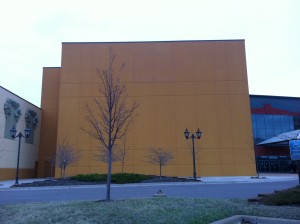For the first time in this long process, the City of St. Michael and Riverside Church will turn its ongoing discussion over a possible church use in the former St. Michael Cinemagic Theater over to the public.
The St. Michael Planning Commission will host the first of two meetings set to discuss the request by Riverside to allow the establishment of a church facility within a commercial (B1) district, something that isn’t necessarily within the city’s guidelines, but could be allowed when referring to federal law.
The planning commission will place the item on its agenda at tomorrow’s meeting, set for 7 p.m. on Oct. 1 at the St. Michael City Center’s main council chambers.
It will also be time for Riverside to unveil its designs and plans for the former theater site, which housed more than a dozen screens and separate areas for a bar and restaurant when it was first designed and opened more than eight years ago.
 Now, the site has been closed down for longer than it was actually opened, and Riverside presents the second actual proposal that’s made its way to city staff and elected officials. Hom Furniture made a pitch for the building about three years ago, but couldn’t make the site work, eventually moving down the road to the former Lowe’s location in Rogers.
Now, the site has been closed down for longer than it was actually opened, and Riverside presents the second actual proposal that’s made its way to city staff and elected officials. Hom Furniture made a pitch for the building about three years ago, but couldn’t make the site work, eventually moving down the road to the former Lowe’s location in Rogers.
No action is expected on the proposal Wednesday night. The planning commission, after two join-meetings with the St. Michael City Council, will formally discuss the Riverside proposal, and then move the item onto November’s agenda pending a traffic study conducted by both Riverside and the City of St. Michael.
St. Michael City Administrator Steve Bot and city staff have both said the traffic study is warranted, thanks to changing traffic patterns at the site. Kwik Trip, for example, was not in its current location when the traffic study was conducted for the St. Michael theater location back in 2004-2005. That complicates the in-and-out traffic at the intersection of Highway 241 and O’Day Avenue Northeast.
Bot has also said a defined plan offered by Riverside – one that looks specifically at use throughout the building, beyond simulcast screens that will display regular church services broadcast from the church’s home location near Monticello – will help staff and board members decide how best to move to the next step in the Riverside/St. Michael discussion.
Hanging over the meeting is action by the church, which has indicated it would take legal action against the city if the ordinance that does not allow churches in commercial areas is not change. A letter sent earlier this summer said the church is prepared to take legal action.
“It’s not something we want,” said Skipp Machmer, one of the church’s two pastors. ““We felt we had no other options.”
The church is pointing to a federal act – the Religious Land Use and Institutionalized Persons Act – as its legal standing behind the request to allow an assembly in a former area used as a theater.
However, said co-Pastor Tom Lundeen, the city’s logic is flawed when it comes to a church like Riverside. The weekly assembly in Monticello draws more than 1,750 people. Putting something like that in a neighborhood “simply wouldn’t work, logistically. It’d be a nightmare for any neighborhood.”
The city is firm in its belief the area should continue to be a commercial site, according to the city’s Comprehensive Plan. City Attorney Dave Lenhardt said he understands the church’s legal request, and is still exploring the application of RLUIPA in this particular case.
“It appears to apply in some ways, but the interesting thing is the 8th Circuit [federal court – based in Minneapolis] has never made a ruling on such a case, so there’s very little to go on that would apply to our area,” he said.